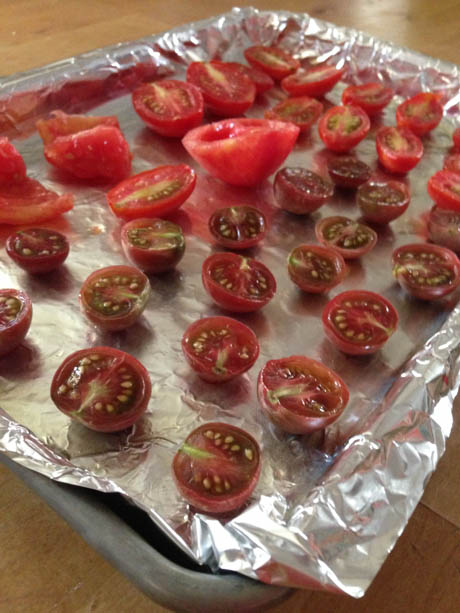Oven roasting tomatoes
Over the weekend I did demos at our local Austin farmers’ markets showing two ways to dry tomatoes. I used my dehydrator for some, which I’ve detailed in this post with the exception that I peeled and for the most part seeded my larger tomatoes, even the plum varieties and I was pleasantly surprised by the shortened and fairly even drying time.

If dehydrating isn’t in your plans, then an oven roast is a great idea too. This is a project that you might start when you have plans to be elsewhere or do it overnight. Summers and low-and-slow oven cooking might rub you the wrong way, but I’m fairly pleased with how little my kitchen heated up and with what great results I got.
Oven roasting tomatoes
1. Preheat oven to 250 degrees F or 200 degrees F with a convection oven.
2. Prepare tomatoes by keeping the skin on and cutting them in half from stem to blossom end. Cover a cookie sheet with foil (because it might get sticky with the caramelized tomato sugars) and coat the foil with olive oil (or the dried tomatoes will stick and very difficult to remove).
3. Place halves face up on the cookie sheet and drizzle them with olive oil and, if you’d like, a pinch of sea salt.

4. Bake them at 250 degrees F (or 200 degrees F on convection) for as long as it takes for them to be reduced to a dryness you like.
Cherry tomatoes will take less time, around 4-6 hours. Bigger tomatoes will take 8-10 hours or more. You really can’t burn them at this low temperature, but they will blacken from the caramelization process. If roasting multiple sizes on the same tray, pull out the smaller ones when they’re done and let the rest continue to cook.
5. Store in an airtight container or bag in the refrigerator for up to 2 weeks or freeze them for longer-term storage and pop them out as you need them.

Use both dehydrated and oven roasted tomatoes in sauces, soups or risottos, or in spreads like pestos or hummus. They also make great snacks straight from the jar/bag! Dried tomatoes contribute a concentrated umami blast to dishes, so use them in places where you might use mushrooms or where you’re looking to develop flavor and complexity in a dish.





 Monday, June 24, 2013 at 7:00AM
Monday, June 24, 2013 at 7:00AM


Reader Comments (1)
Perfectly provided information in this publish. Thanks for publishing such useful details.